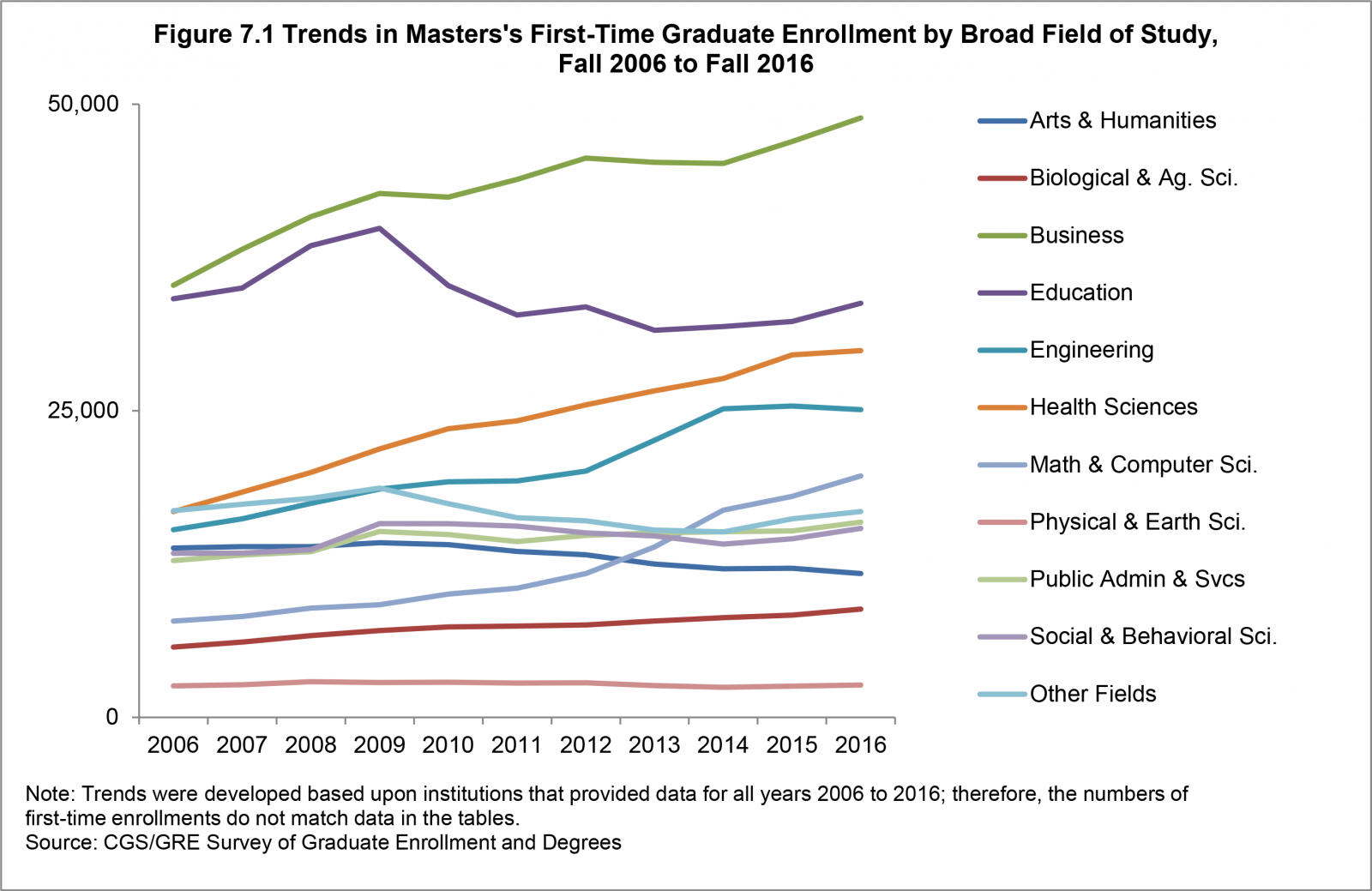You are on CGS' Legacy Site.
Thank you for visiting CGS! You are currently using CGS' legacy site, which is no longer supported. For up-to-date information, including publications purchasing and meeting information, please visit cgsnet.org.

Hironao Okahana, Assistant Vice President, Research & Policy Analysis, CGS
Enyu Zhou, Education Research Analyst, CGS
A large majority of graduate students in the United States pursue master’s degrees. According to the most recent CGS/GRE Survey of Graduate Enrollment and Degrees (GE&D), more than twice as many applications for admission were submitted to master’s programs than doctoral programs, and four out of five first-time graduate students enrolled in Fall 2016 were enrolled in programs leading to a master’s degree or a graduate certificate. Furthermore, the large majority (83%) of degrees awarded in 2015-16 were master’s degrees, while the share of doctoral degrees was 11% and graduate certificates was 6.2%. The sheer size of the student body and degrees awarded make master’s education a critical part of the graduate education enterprise that affects institutional missions, enrollment models, and financial planning across different sectors of higher education. This article highlights several results from the most recent GE&D survey that pertain specifically to master’s education.
Application & First-time Enrollment
The volume of applications for admission to master’s programs continues to increase. Between Fall 2015 and Fall 2016, applications for admission to master’s/other programs increased 1.4%, which was a larger rate of growth than that of doctoral applications (0.8%). Over the last ten years, between Fall 2006 and Fall 2016, master’s applications grew on average by 7.0% each year, while doctoral applications only grew by 3.3% annually. Also on average, first-time graduate enrollment in master’s programs grew by 3.1% annually between Fall 2011 and Fall 2016, compared to 2.7% in first-time doctoral enrollment.
Figure 1 shows the trends in first-time master’s enrollment by broad field of study for the decades spanning Fall 2006 to Fall 2016. The increases in first-time master’s enrollments have been particularly large in business, health science, engineering, and mathematics and computer sciences. Though it is a smaller field of study in comparison, biological & agricultural sciences continues steady growth in first-time enrollment. The first-time enrollment in education master’s programs remains the second largest broad field of study, despite the sharp drop in first-time enrollment in the early 2010s. In addition, first-time enrollment in education master’s programs appears to be slowly rebounding from previous declines (since Fall 2013).

On the other hand, the first-time enrollment in arts and humanities master’s programs has slowly declined since Fall 2009. It also appears that the growth in mathematics & computer sciences has slowed down significantly, and first-time enrollment in engineering master’s programs has flattened in recent years. These two fields of study enroll many international students—61% and 56% of first-time master’s and doctoral students in Fall 2016. Given the current policy and political climate surrounding Optional Practical Training (OPT) and H-1B visa programs, this is an area that may warrant continued attention from the graduate education community.
Women comprised a larger majority (59%) of first-time enrollment at the master’s level than at the doctoral level (53%) in Fall 2016. In particular, more than three out of four first-time master’s students in health sciences (79%), public administration and services (79%), and education (76%) were women. In contrast, women comprised a minority of the students in master’s programs in engineering (26%), mathematics and computer sciences (36%), and physical and earth sciences (46%). However, the percentage shares of women in mathematics and computer sciences and physical and earth sciences were much greater in comparison to doctoral programs (27% and 36%, respectively). This indicates that in these fields, master’s programs play an important role in facilitating women’s participation in the advanced STEM workforce.
Total Master’s Enrollment & Degrees Conferred
Nearly three out of four (74%) graduate students at the institutions that participated in the Fall 2016 GE&D survey were in master’s programs. In fields such as business (94%), public administration and services (93%), education (79%), and mathematics and computer sciences (78%), the share of master’s students was particularly robust. It is not surprising that more than nine out of ten (94%) graduate students at Master’s Colleges and Universities were enrolled in master’s programs. However, it is noteworthy that about three out of four graduate students at Doctoral Universities with Moderate Research (77%) and Higher Research (75%) were also master’s students. Furthermore, even at Doctoral Universities with Highest Research activity, 63% of all graduate students in Fall 2016 were pursuing master’s degrees.
Similarly, more than four out of five (83%) graduate degrees and certificates awarded between 2015-16 at the institutions that participated in the Fall 2016 GE&D survey were master’s degrees. This compares to 11% for doctoral degrees and 6.2% for graduate certificates. Not surprisingly, 90% of graduate degrees and certificates awarded at Master’s Colleges and Universities were master’s degrees. However, more than eight out of ten graduate degrees and certificates conferred by Doctoral Universities with Highest Research (80%), Higher Research (81%), and Moderate Research (84%) were also master’s degrees. These enrollment and degrees data reinforce the idea that master’s education is an integral part for all sectors of the graduate education enterprise.
Institutions participating in the Fall 2016 GE&D survey reported a 3.2% increase in the number of master’s degrees awarded between 2014-15 and 2015-16, compared to the 2.7% growth in doctoral programs. The increase was particularly robust at Doctoral Universities with Moderate Research (8.2%), although, these institutions also reported a high rate of increase in the number of doctoral degrees awarded (7.0%). Interestingly, the number of doctoral degrees awarded by Doctoral Universities with Higher Research decreased by 6.2% between 2014-15 and 2015-16, while the number of master’s degrees awarded remained virtually flat (0.8%). The increases in the number of master’s degrees awarded between 2014-15 and 2015-16 were particularly robust in biological and agricultural sciences (15%), health sciences (14%), and engineering (12%). However, numbers declined in arts and humanities (-3.7%) and social and behavioral sciences (-0.3%).
Discussion
Master’s education encompasses a wide range of programs and fields of study. It is a segment of the graduate education enterprise that is difficult to analyze given the diversity of students it serves and the workforce needs it aims to address. Nevertheless, as the only national data source that captures comprehensive application, enrollment, and degrees data on master’s degrees in all fields, the GE&D survey offers valuable insight into the graduate education community. These insights are meant to help advance campus-level conversations that will lead to innovative, responsive, and distinctive approaches in master’s education.
The U.S. workforce needs more master’s degree holders, but graduate programs will need to closely align their curriculum to offer skills and competencies needed for graduates to be successful. The CGS Master’s Committee has developed the Alignment Framework, a model that provides a roadmap for graduate deans and institutional leaders to create workforce-ready high-quality master’s programs that can best serve their region, state, and beyond. In addition, CGS, in partnership with Educational Testing Services, has launched an investigation of master’s admissions practices titled Master’s Admission Attributes: Current Status and Missing Evidence. Through four regional focus groups, the project will attempt to connect master’s admission criteria to outcomes and competencies and inform future admissions practices.
Beyond these projects, CGS encourages the robust exchange of ideas and promising practices surrounding master’s education among our member deans. At the upcoming Annual Meeting, there will be a pre-meeting workshop session that focuses on master’s enrollment management, as well as several concurrent sessionsthat focus on master’s topics. In the meantime, we encourage our members to take advantage of the Dean’s Discussion Board to pose questions and/or share insights with fellow graduate deans on this topic.
The full report of the most recent CGS/GRE Survey of Graduate Enrollment and Degrees, Graduate Enrollment and Degrees: 2006-2016, is available online. For questions regarding the report and this article, please contact Enyu Zhou, CGS education research analyst. For inquiries regarding CGS Master’s Projects, please contact Robert M. Augustine, CGS senior vice president.




